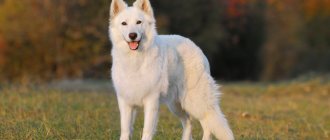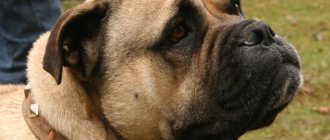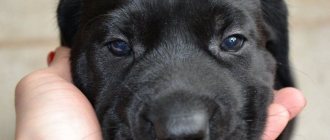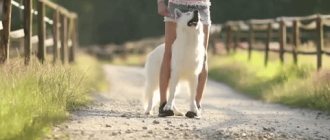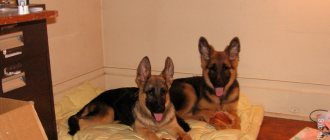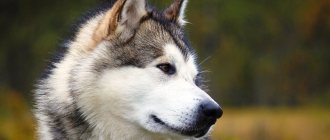Brief historical background
Oddly enough, Switzerland is not the birthplace of this breed, which has common roots with German shepherds. These dogs were used to guard sheep flocks. They had to quietly infiltrate the herd so as not to attract the attention of the wolves. Therefore, dogs with snow-white fur were considered the most valuable shepherds. Over time, the need for such dogs completely disappeared and at the end of the 19th century their numbers decreased so much that they began to be considered exclusive.
It was possible to save part of the existing livestock only thanks to the focused work of the German captain Max von Stephanitz, who bought a white dog named Hector. After the Nazis came to power, such puppies began to be culled and destroyed. But in the 1970s, several snow-white dogs were brought to Holland and Switzerland. Local breeders became seriously interested in them and began work to improve and consolidate the necessary qualities. The result of their work was the White Swiss Shepherd, officially registered in 2003.
Further breeding of BShO
In America and Canada, white shepherds were accepted with a bang; they tried to correct some behavioral problems directly related to health problems using an individual approach to each dog, believing that developmental deficiencies can be corrected with proper education. White dogs were mostly in private hands; their upbringing and development were monitored by specially trained people, who would later be called “zoopsychologists.”
Only thanks to this approach to each individual was it possible to preserve most of the white stock. However, in order to preserve this livestock, animals with creases in the tail, blurred color, incomplete set of teeth, small size, unstable psyche and other defects incompatible with the concept of “German Shepherd” were allowed for breeding. The goal was to preserve the white fur of a dog that looked like BUT.
USA and Canada
By 1964, there were enough such animals in the United States to open the California club of white German shepherd lovers, but it soon had to be dissolved (1968) under the pressure of indignation from breeders in Germany, where BUT After the war, it was considered one of the national breeds of the country and white color was not included in the breed standard.
The Canadian Kennel Club acted more cunningly: it did not prohibit the color, but classified it as an undesirable defect, and later, in 1971, it created a separate club “White Shepherd” without reference to the word “German”.
Due to the fact that the German Shepherd standard did not include white color, the white shepherd was forbidden to be called German
In the same year, Americans joined them and the community received the name “American-Canadian White Shepherd” (ACWS).
The name "American-Canadian Shepherd White" became the official name for this breed and existed until 1998. Under this name, dogs came to England, the Kingdom of the Netherlands, Belgium and Switzerland in the 70s.
How “American-Canadian” became “Swiss”
These countries favorably accepted the overseas dogs and recognized them as a separate breed, and Switzerland offered its assistance in smoothing out some of the rough edges associated with ill-conceived selection.
For this purpose, a snow-white male Lobo (born 1966) arrived from America to Switzerland, who is recognized as the progenitor of almost all white shepherd dogs in Switzerland - his descendants are listed in the stud books of many clubs in Europe and Switzerland. Descendants, but not himself. Why?
Lobo himself was of the correct build and had no developmental defects, but was too large and heavy to be considered a partner or service dog.
Switzerland proposed to work on Lobo's data to reduce it, resulting in a tireless, agile, maneuverable dog, moderate in nutrition and easily transported, both on its own and by any means of transport.
Lobo, weighing almost 60 kg with a height of 70 cm, had a hard time with field tests: he lost his paws on rocky ground, lost a lot of maneuverability on mountain slopes, quickly overheated, and refused to work due to rapid, hoarse breathing in the rarefied mountain air.
Such shortcomings in height and weight were eliminated by competent selection work by Swiss breeders, who managed to preserve and consolidate the best qualities inherited by American-Canadian shepherds from their German ancestors.
These are the dogs that are the most desirable type for the working group, these are the ones that Swiss breeders made the raw, unfinished type of American-Canadian Shepherds, and these are the shepherds that began to be registered in the Swiss Stud Book (1991) as White Swiss Shepherds (BSS).
BShO are not interbreed crosses! This is the product of long-term selection work, which led to the creation of an independent breed that carries the noble blood of the German Shepherd, although matings between BShO and NO have been prohibited since 2003.
BShO is an active dog that requires long walks several times a day
IFF and UCI
The Fédération Cynologique Internationale recognized the name White Swiss Shepherd, rejecting claims to the breed by the Canadian Kennel Club, for 4 reasons:
- Switzerland has completed the formation of the breed.
- Switzerland has applied for recognition of a separate status for the breed.
- Switzerland has the largest population of dogs of the desired type.
- Canada is not a member of the FCI, therefore it is simply not ethical to approve a breed with the word “Canadian” for the FCI.
We must give credit to the breeders from Canada. The first copy of the BUT was registered in this country back in 1919. There is no information about coat color, but in 1922 the Association of German Shepherd was organized in Canada, and in 1959 - out of 200 registered in the breeding book of animals, 130 have “color-white”. The breeding program for white-haired shepherds almost completely coincided with the conservation program for these animals in the United States.
Moreover, the California club of white German shepherd lovers joined the “White Shepherd”, which helped preserve the dogs belonging to the American club.
Paying tribute to the work of Canadians, the International Union of Canine Clubs (UCI) recognizes two names at once and puts an equal sign between them:
- White Swiss Shepherd.
- American-Canadian white shepherd.
Distribution and purpose
Experts believe that real BShO are those that originate from Swiss breed lines. In Russia, the first white shepherd dogs appeared only in 2004. In the recent past, only two dozen nurseries engaged in breeding this breed were registered in the post-Soviet countries. But now their number has begun to increase.
According to the international standard, this breed belongs to the group of family companion dogs. But thanks to a successful combination of working qualities, they are successfully used as rescuers, guides and search engines.
Choosing a puppy
Due to the fact that this is a relatively new breed for Russia, white shepherd puppies should only be purchased from kennels or clubs.
Before purchasing an animal, you need to clarify some important points:
- experience and history of breeding in this nursery;
- reputation and image of the breeder;
- exhibition activities of parents.
Inquire about the baby’s health status and whether any hereditary diseases may “lurk” for him. Have you been vaccinated and when is the next vaccination due? As a rule, decent breeders who value the reputation of their own enterprise do not hide any shortcomings or defects of their pupils from future owners.
Dog handlers who breed these animals believe that these dogs are prone to the following diseases:
- joint dysplasia;
- deafness;
- heart failure.
Description
The BShO is a stately and very beautiful dog with harmoniously developed muscles and a luxurious white coat, which makes it possible to distinguish it from a German shepherd. Depending on the gender, the height of an adult animal is 61-66 cm, and the weight varies between 25-40 kg.
The neat wedge-shaped head with a pronounced central groove and a distinct occipital protuberance has dark almond-shaped eyes and high-set ears resembling isosceles triangles. Strong, powerful jaws with white teeth are covered with tightly fitting dry lips.
The muscular, gracefully arching neck smoothly transitions into high withers, a flat, strong back, a muscular loin and a wide, slightly sloping croup, ending at the base of a saber-shaped, well-furred tail.
Under the powerful, moderately stretched body of the White Swiss Shepherd, a description of the breed of which is difficult to squeeze into a few short lines, there are even, parallel limbs with an excellent balance of ligaments and muscles.
The entire body of the animal is covered with short or long hair, under which a dense undercoat is hidden. As for color, the standard allows only white. In this case, dogs have a black nose, pigmentation of the lips and edging of the eyelids.
Choice
If you want to purchase an American-Canadian White Shepherd, then it is important to determine exactly what such a dog is needed for.
If for show exhibitions, then be prepared that the snow-white handsome man (beauty) can present an extremely unpleasant surprise in the form of a weak nervous system - nervousness, cowardice or aggression.
And you will have to put up with a cowardly shepherd dog next to you for 12-14 years, since this is the lifespan of the BShO.
If this suits you morally, then be prepared to pay about 30-50 thousand rubles for a puppy.
BShO gets along well with all family members, children and other pets
In addition, show-class dogs rarely have the qualities necessary to actually protect the territory and the owner. Demonstration sports performances with BShO have little in common with real protective qualities, which are based, first of all, on the instincts of the breadwinner and the protection of offspring. These qualities have been artificially exterminated in show dogs!
Moreover, this shepherd dog must be TAUGHT TO BITE - she loves people so much that without special training she cannot break this “taboo”.
Of course, a white handsome dog (beauty) is quite suitable for scaring off intruders from a car or along the perimeter of a site - they love to bark, but in a direct attack the dog will become confused if the owner is not nearby or the BShO has not completed a special course. training.
“Ein Hund, der seinen Schwanz schützt” - the Swiss themselves say about the shepherd dog - “A dog that protects its tail.”
The other side of the coin is that the owner does not have to fear for his children and other pets. The loving nature of the American-Canadian woman will not allow her to cause the slightest damage to her household. The shepherd will be happy to “graze” everyone who lives with her under the same roof, but even here you can’t count on protecting the “herd.”
In Canada and the States, this breed is used as a rescue and search breed (after training) with the same frequency as retrievers in Russia.
When choosing a companion and protector, a watchman and a family friend, you should pay attention to shepherd dogs from working breeding lines, where dogs are selected not only for their appearance, but also for their behavior.
Good dogs are not obtained after studying various training disciplines; their attitude to work must be embedded in the genetic characteristics of the breed.
A good working BShO is a large, strong individual with a well-controlled type of desired behavior.
Puppies from working lines are cheaper - from 10 to 30 thousand rubles, depending on the working qualities of the parents.
If you do not plan to participate in exhibitions, it is better to purchase a BShO working line
Behavioral features
The White Swiss Shepherd is a dog with a cheerful, sociable character. She is determined to constantly communicate with people and extremely rarely shows causeless aggression. She is very disciplined, responsible and hardworking.
The main character traits of representatives of this breed are excellent trainability, obedience and balance. These dogs easily find a common language with their owner’s children and get along well under the same roof with other pets. They do not tolerate humiliation and, out of boredom, are prone to idle talk.
Characteristics of the Swiss Shepherd
Swiss Shepherds are cheerful, disciplined, sociable and hardworking animals. These dogs are excellent companions and need regular human interaction.
Pets are ready to be with their beloved owner all the time. For them, both active pastime in the fresh air and lounging on the sofa are equally pleasant. Dogs cannot stand loneliness and boredom, they are ready to follow their owner always and everywhere and take an active part in the life of the whole family.
The Swiss Shepherd is great for people with an active lifestyle. The breed can also be recommended to families who are keen on sports: many pets successfully engage in agility, coursing, freestyle, and bikejoring.
Shepherds show boundless patience towards younger family members and consider taking care of them their duty. Showing incredible delicacy, they can play with them for hours. It is with children that pets are on the same wavelength of worldview, emotional reactions and physical activity.
BShO treat young children with care and tenderness, and in case of danger they will always protect them
BShO belong to a breed that gets along well with all pets. Shepherd dogs perceive any cat or dog not as a rival, but as a playmate.
In relation to strangers, animals behave warily and restrainedly, but without excessive aggression.
Shepherds have a developed protective instinct, which makes them excellent bodyguards and sensitive guards of their owner's territory.
The breed's disadvantages include excessive barking, but this can be dealt with through early socialization.
Maintenance and care
BShO are unpretentious animals that feel equally comfortable both in a city apartment and in a spacious private house with a large plot enclosed by a high fence. If the dog is kept outdoors, it is necessary to build an indoor enclosure with an insulated booth.
When it comes to coat care, both long- and short-haired White Swiss Shepherds need to be brushed regularly with a special brush. This will speed up the shedding process and get rid of dead hairs. Since the animal's snow-white fur quickly becomes dirty, it will have to be bathed periodically in warm water with a small amount of shampoo. Upon completion of the procedure, the dog should be thoroughly dried with a towel and thoroughly dried with a hairdryer. Plus, both short- and long-haired White Swiss Shepherds need systematic nail trimming, eye rubbing, and teeth and ear cleaning.
Introverted Sheepdog
BShOs have this nuance: they are introverted dogs, fixated on their owner and wary of strangers. This fundamentally distinguishes a shepherd from a terrier. The badger was always so open to the world, rushing towards everyone, was happy with everyone around him - sometimes it even infuriated me.
The wind only needs me, but it is wary of the world and is reluctant to contact it.
Knowing this feature of the breed, I spent a lot of time socializing Wind - I constantly took him with me to different places. Now I have a sociable BShO, not the most characteristic representative. Considering that I am constantly in company, I needed a dog that communicates with other people without phobias or aggression.
Wind is a very delicate dog, well-mannered, and always avoids conflicts. He is very soft - a mama's boy. I don’t like this about him, but it is what it is.
I realized that I love, understand and accept him as such. Although this is not at all how I imagined a shepherd.
Now I’m not joking at all when I call him my ideal “shepherd.” For me, Wind is ideal; for example, he has no zoo aggression. When I walk down the street with him, dogs can jump at him, bark, and become aggressive; he looks at them very surprised, and then switches to me and doesn’t notice anyone at all. The wind has more than enough for “his” person - and for “his” person he is ready to do literally anything.
In the fall, we went on vacation to a house by the lake, which was located on the opposite side of a small village. It was more convenient to get food by water. We needed something, we jumped into the boat and sailed. I somehow calmly left the wind to run around and did not close the houses. We set sail, the wind ran along the shore - into the water... and floats towards us. My friends tell me: “Don’t worry, yesterday the husky also swam for its owner and quickly returned to the shore.”
And I look at this guy, he has determination in his eyes. I say, turn around, this is a shepherd dog, he will swim to the end. It's cold, November. In general, we returned.
And he’s like this in everything, even in the summer he doesn’t let me swim far, he controls me all the time and tries to turn me towards the shore with his body.
Dietary recommendations
The feeding regimen of such animals directly depends on age. If it is enough for an adult dog to eat twice a day, then a puppy should be given three to six times a day. Each owner decides what exactly to feed the dog independently, based on their capabilities.
Those who have chosen the so-called drying for their ward can be recommended to give preference to holistic or super premium class products produced by a trusted company. It is important to ensure that the purchased food does not contain a single gram of preservatives, dyes or grains.
Those who decide to give preference to natural meats need to remember that the basis of such nutrition should be raw meat. It must be supplemented with a small amount of rice, buckwheat and vegetables. Also, the dog menu should contain eggs, offal, low-fat sea fish, cottage cheese and yogurt. It is advisable to give your four-legged pet special vitamin and mineral supplements twice a year.
The animal's diet should not contain chocolate, sweets or baked goods. It is strictly forbidden to treat a white Swiss shepherd with long bones, river fish, legumes, onions and potatoes. Also on the list of taboos were fried, spicy, salted and smoked foods.
Life with BShO is...
Wool, a lot of wool, it's complete trash. Every morning, walk around the apartment with a vacuum cleaner - instead of charging. It's just a nightmare in the car. I have a passenger car, and the dog travels in a hammock because the cage does not fit in the trunk. There's enough wool there for one more dog. Previously, I was almost cursed at the car wash; every time I had to endure disdainful looks: “What’s wrong with your car?!” But, lo and behold, I found “my” car wash, where they greet me like family.
One day I came just to wash the car a little and I said: “Guys, please don’t look into the salon, because you will be scared, and I will be ashamed.” They laughed at this phrase and invited me to another day, when they would have enough free time to put my car in order.
Upbringing
BShO is a smart dog endowed with high intelligence. She is easy to train and quickly remembers new commands. To speed up the process of training your White Swiss Shepherd puppy, you should start soon after he moves to his new home. The educational process must be systematic and consistent. This means that you should not allow your little pet to do things that would be prohibited to an adult animal.
It is important to accustom the puppy to his name, collar and leash. It is also necessary to socialize him as early as possible. To do this, you should regularly walk with your baby in crowded places. Thanks to such actions, the puppy will quickly get used to various stimuli and learn not to pay any attention to them. By the age of one year, the dog must clearly and unquestioningly carry out basic commands, such as “Come to me”, “Fu”, “Nearby”, “Place” and “Stand”. Thanks to this, you can easily control its actions in any situation.
Education and training
These dogs require constant and consistent training. Both the puppy and the adult animal should be handled gently. The character of the white shepherd is strikingly different from the character of the German one. Harsh training methods are strictly prohibited. For a white shepherd, physical activity is necessary. Perhaps not as serious as for the German one. Your pet will be immensely happy if you allow him to run around with a stick or ball, catch a flying disc, or frolic in the company of his fellow animals.
The dog is very smart, so it is easy to train. She can master several “professions”: rescuer, therapy dog, guide dog. A properly trained animal is capable of guarding and protecting. Self-training can give good results.
Tendency to diseases
Judging by reviews from owners, White Swiss Shepherds are strong dogs with excellent health. But, despite good immunity and excellent genetics, the body can malfunction. Therefore, these dogs are sometimes diagnosed with atopic dermatitis, diabetes mellitus, intussusception, eosinophilic myositis, hind limb paresis, and dysplasia of the elbow and hip joints.
Plus, they can get plague, rabies, parainfluenza, adenovirus, leptospirosis, coronavirus and parvovirus enteritis. To prevent these diseases, the dog must be regularly vaccinated with complex vaccines. As a rule, the breeder does this for the first time. And subsequently the owner repeats this procedure annually.
Keeping a White Shepherd
- The breed is freedom-loving, so for good development it needs more space. The best place to keep it, as for any large dog, is considered to be a country house. An albino is not suitable for small apartments.
- To maintain your dog's natural physical fitness, it is necessary to carry out regular jogging with weights.
- Grooming should be regular, especially during shedding. You need to brush your dog once a week.
- Once every six months, the shepherd's nails are trimmed with a nail clipper for a large breed.
Tips for choosing
Those who are seriously thinking about buying a White Swiss Shepherd puppy, the photo of which will be published in today’s article, should immediately discard the idea of going to the bird market. There, under the guise of healthy purebred dogs, mixed breeds or sick animals are often sold.
Therefore, it is better to contact professional breeders or a specialized nursery. There you will not only be provided with guarantees of the authenticity of all accompanying documents, but will also be shown at least one of the parents of the litter being sold.
It is extremely important to pay attention to the behavior and appearance of the puppies offered. They should be moderately well-fed, with beautiful white fur, clean ears, non-watery eyes and soft bellies. Small shepherd dogs with a pedigree character will definitely show interest in new people. They should not be overly aggressive or fearful.
“I sadly walked with the Wind on a leash”
To say that I immediately realized that Wind was “my dog”, probably not. It took me a couple of weeks to get used to him, because he was completely different: very careful. It took me a long time to teach Vetra to go into the elevator, for example. After Badger, a dog who was not afraid of anything in life, it was strange and unusual.
Since childhood, I have never walked with Badger on a leash: I knew that he would not rush after a pigeon, would not be afraid of any sharp sound, everything was clear with him. With Wind, I sadly walked on a leash and thought that never in my life would I be able to let him go, because I did not understand my new dog’s reaction to the world around me and to me. Luckily it only lasted two weeks.
As my friend later said: “You get old, so you start having comfortable dogs.” Wind really is so comfortable, he always does whatever you ask him to do without hesitation. By the way, I constantly sorted things out with the terrier. Shepherd dogs are different, they do not become willful.
Advantages and disadvantages
Like any other breed, the White Swiss Shepherd has a number of undeniable advantages. The main positive qualities include a good-natured attitude towards children and the ability to distinguish a real threat from an imaginary danger. No less valuable features of these animals are selfless devotion to their owners, quick learning, curiosity and the ability to get along under the same roof with other pets.
The main disadvantages of representatives of this breed include the need for frequent washing and a tendency to “concerts”. A bored dog that is not provided with proper physical and mental exercise will certainly begin to give loud vocal signals.
What have we taught each other?
I teach the wind to be open to the world and sociable. He is a very soft dog, sensitive - probably he is teaching me to be softer. He also taught me to be more patient and sensitive - to have enough patience to find the key to him. And when you find this key - it’s just space! The dog understands everything at a glance.
In general, thanks to the Wind, my attitude towards dogs has completely changed. When you understand what they are capable of, what cosmic potential they have that can be used and developed, you begin to appreciate them even more.
White Swiss Shepherd: reviews of the breed
People who live near these noble beauties claim that these dogs are ideal for active families with small children. They adapt equally easily to both enclosure and apartment living. However, in the latter case, the dog should have the opportunity to regularly splash out the accumulated energy. If you do not systematically burden him both mentally and physically, he may acquire the bad habit of constantly barking, and this is fraught with serious problems with his neighbors.
Since white shepherds are relatively large in size, they are quite problematic to keep on a leash. To prevent every trip outside from turning into a real nightmare, the dog must be taught basic commands and how to calmly walk next to its owner. When properly raised and educated, these animals make reliable guards and excellent companions on long walks.
Puppy in the house
I felt that Badger would not be very happy about the appearance of his “younger brother,” but I really wanted them to cross paths, because I secretly hoped that the Wind would take on his best qualities and that Badger would help me with my upbringing. And so it happened.
I didn’t notice at all that I had a puppy in the house, that I needed to close something, clean it up.
I had no problems raising a new family member; he had an older example of an absolutely ideal, well-mannered dog, so puppyhood was easy and wonderful.
Distinctive features
The White Swiss Shepherd has the following standard:
- The head is strong, well defined, wedge-shaped.
- The eyes are not very large, almond-shaped, slanted; the color is predominantly brown (all shades except light).
- The stop is not expressed.
- The ears are in the shape of a triangle, set high, the coat is insignificant; not docked, erect (stand up by 12 months).
- The nose is small and black.
- The lips are close.
- The jaws are powerful and strong.
- The teeth are strong, white (42 teeth); bite .
- Neck with well defined muscles; average size.
- The skin is smooth, dry, with no folds or wrinkles.
- The body is strong, lean, the muscles are clearly defined.
- The back is straight, elastic; the withers are noticeably pronounced.
- The chest is medium, deep set, oval in shape; the front part stands out.
- The stomach is taut.
- The limbs are strong, straight, parallel.
- The tail is fluffy, low set, reaches the hock joint, saber-shaped; lowered at rest, raised to the line of the back when moving.
- The coat is short or medium (5-6 cm), double, there is a thick undercoat, white; slightly shorter on the muzzle and ears.
- The movements are active, very rhythmic, trot-type.

